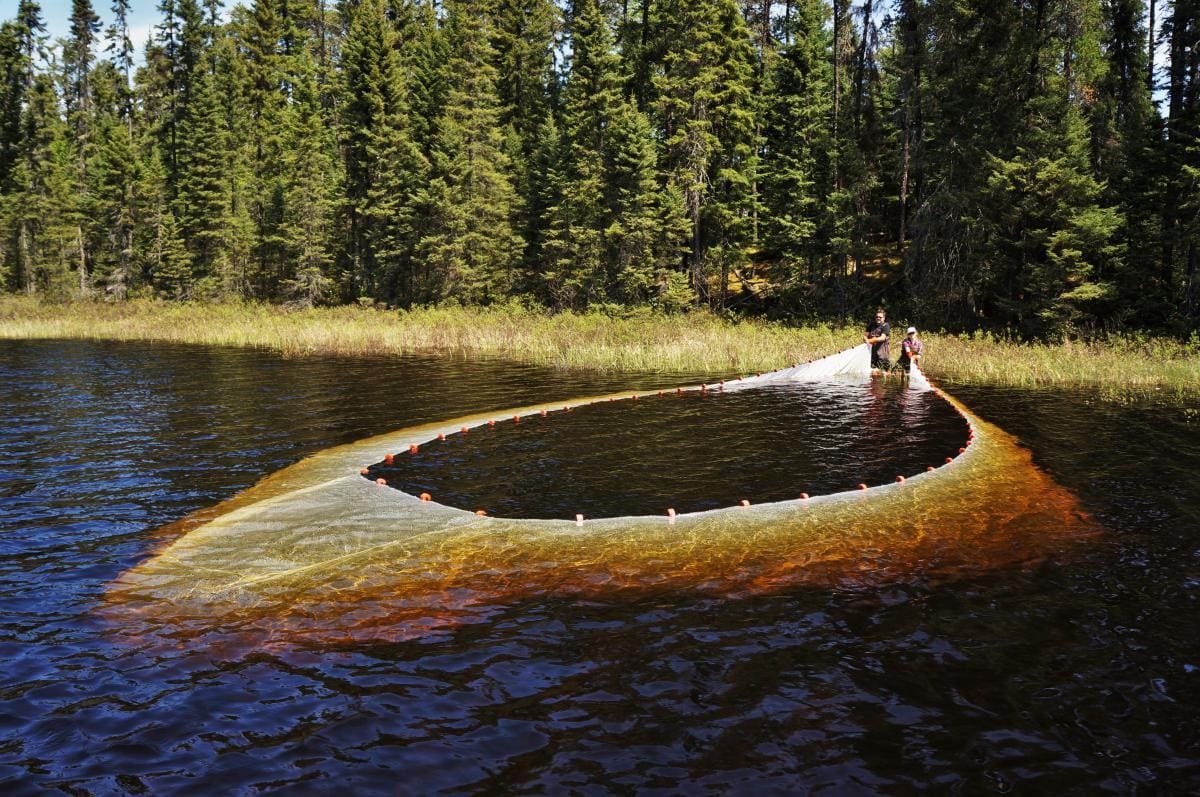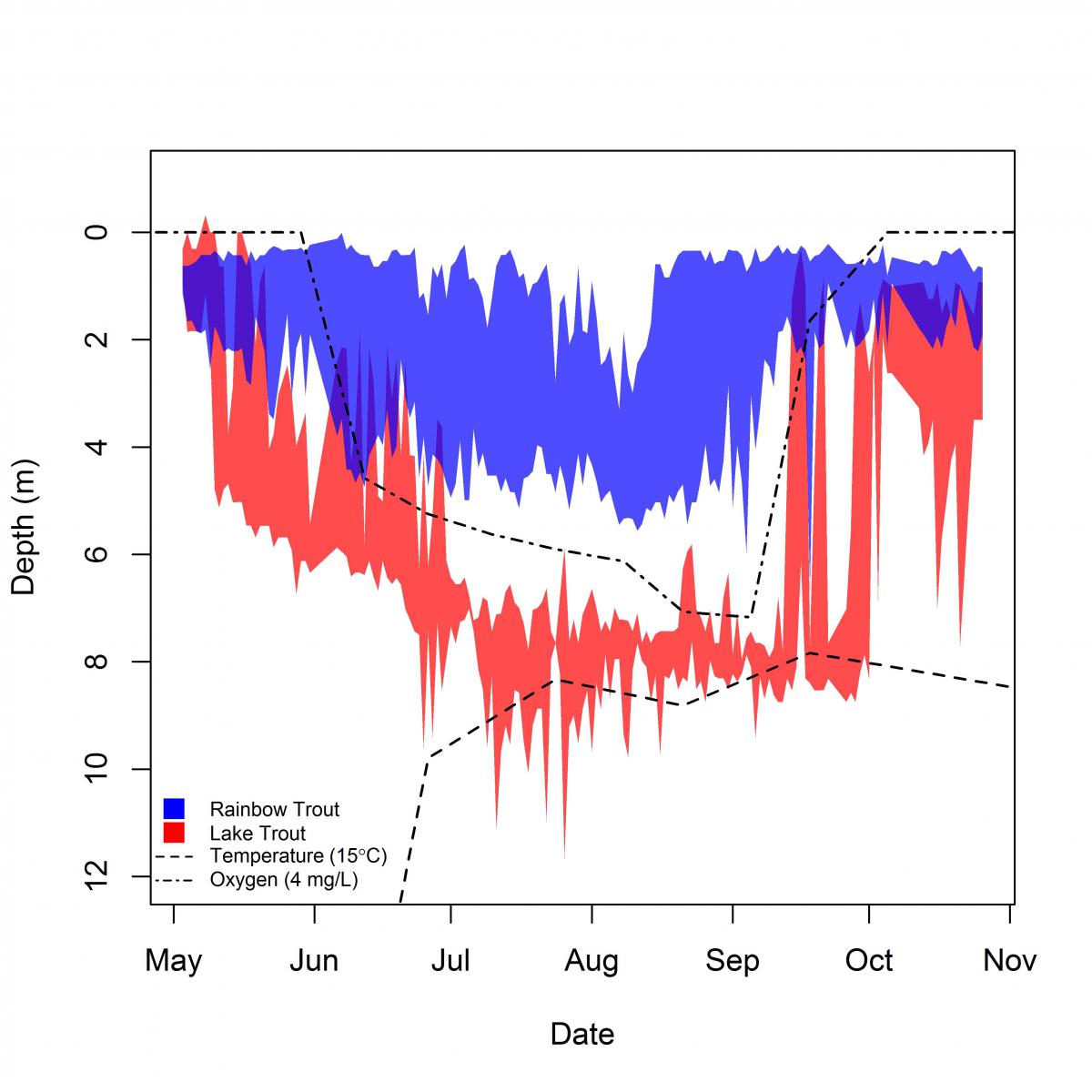Research December 7, 2015
IISD-ELA and Climate Change Part 4: Our Fish are Squeezing into Smaller Habitats
Research at the IISD Experimental Lakes Area (IISD-ELA) includes detailed monitoring of fish using state-of-the-art fish-tracking technology. In the fourth part of our series on the work that is going on at IISD-ELA into climate change, we explore research that has found that lake trout habitats in many lakes are at high risk of declining.

Lake trout are being squeezed
- This happens because preferred habitat for lake trout gets squeezed between surface waters that are too hot and bottom waters where dissolved oxygen is too low. Increases in air temperature and the length of the summer period, linked to climate change, will place this important species at risk of local extinction in many lakes.
- In Figure 1, we can see that in 2007 the preferred habitat for lake trout became “squeezed” as the open season progressed. From mid-August to early September, lake trout only had about 1 metre of usable habitat. Since Lake 375 is about 25 metres deep, this results in a very narrow band where they are able to survive.

Figure 1. Lake trout preferred habitat in 2007 in Lake 375 at IISD-ELA
What’s next?
- Using data from multiple years, we are able to see how water temperatures and oxygen concentrations that affect lake trout habitat are influenced by different climate conditions. With increasing global temperatures, we can likely expect surface lake temperatures to increase as a result. If lake temperatures increase, it may start affecting the habitat available to lake trout. If these changes happen too quickly and the species is not able to adapt in time, it is likely that lake trout near the southern edge of their natural range will begin to disappear.
- Our data also show that lake trout habitat is highly susceptible to changes in poorly oxygenated water in the deep portions of lakes. These low oxygenated waters are associated with nutrient loading and productivity of surface waters—as more organic material is produced through photosynthesis, the material eventually sinks to the lake bottom and is consumed by bacteria (which consume oxygen). So there is a linkage between more nutrients, more algae, more bacteria and lower oxygen concentrations in the deep layer of lakes. These data suggest that, under future warming scenarios, we will have to pay very close attention to the amount of nutrients we allow into our lakes if we want to protect lake trout habitat.
IISD Experimental Lakes Area, Climate Change and the Boreal Forest
IISD-ELA is located in the boreal forest, which represents the largest ecozone on the planet, covering 11 per cent of the planet’s total surface. Within Canada, the boreal forest dominates the landscape, covering 53 per cent of the total land surface. The boreal forest and aquatic systems play a large role in the global carbon budget.
However, the boreal ecozone is changing. A history of more intensive land use, industrial development, electricity generation and resource extraction alter the natural balance in minor and major ways. Most importantly, a changing climate affects water, land and life. Responsible use of our natural resources requires a scientifically rigorous understanding of these systems and how they are changing. Fortunately Canada’s premier freshwater research station has a front row seat and a history of monitoring parameters that can tell us how the world’s northern forests and freshwater lakes are affected by these changes. IISD-ELA brings a 47 year (1969–present) history of monitoring climate, water quality and fisheries in a unique whole-ecosystem laboratory setting. Now, as a part of the International Institute for Sustainable Development, we have the opportunity to use the long-term monitoring dataset of IISD-ELA to examine how climate change is affecting boreal forests, wetlands and lakes from a consistent, long-term, whole-ecosystem dataset of significant scientific and societal value.
As the world’s eyes are focused on the Paris Climate Change Conference, we wanted to take this opportunity to present some of our major climate change research findings to you, so you can see the data for yourself and understand how climate change is affecting our lakes.
You can stay up to date with all the latest news from IISD-ELA by subscribing to our newsletter, and you can donate to the facility here.